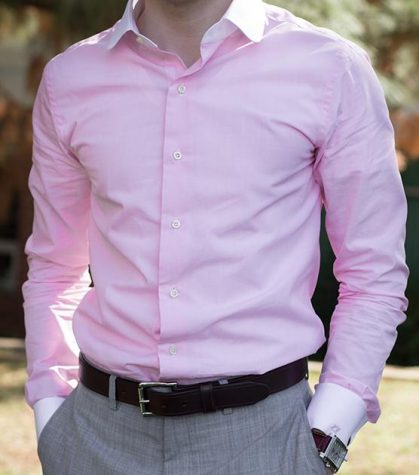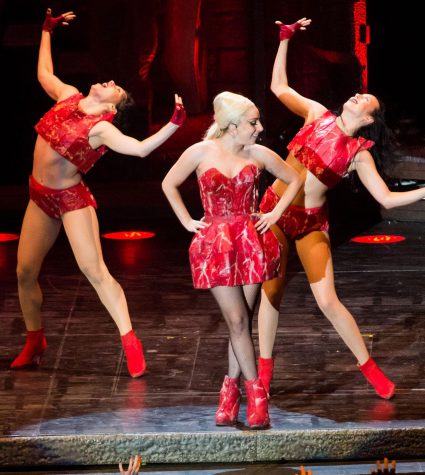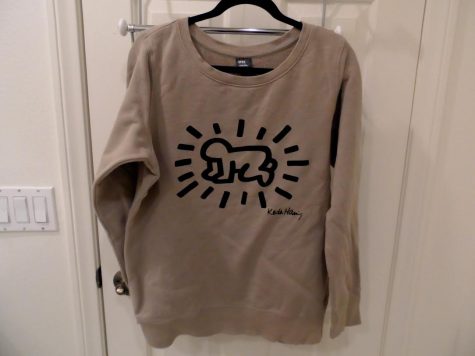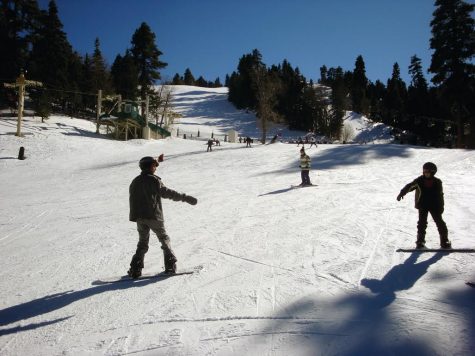A guide for next year’s sophomores
Making memories and narrating news
by Lauren Alparaz
Rather than reporting to a math classroom to solve equations or be assigned section questions to answer in a history class during seventh period, 27 members of Clark’s Publications staff do nothing along those lines each day. Rather, these students interact with students and staff on campus in a social environment and write on a creative, expressive platform about issues and events that affect students.
Publications offers a variety of responsibilities, and though it’s an English elective, it’s much more than that. Chris Davis, Publications advisor said, “Publications provides students with a real-world opportunity to work collaboratively, to problem solve, and to be able to create something of value for others. Most electives, you’re given a certain curriculum, but with Publications it’s more open-ended.”
From a student’s point of view, the open-ended curriculum is both a positive and a negative. It relieves a lot of pressure that comes with a standard core curriculum course, but it also leaves what a student accomplishes in the class entirely up to them. Photo editor Tatyana Aposhian said, “I write for the newspaper a lot, and as for photos, I basically work with Renita [Moradian] to manage, troubleshoot and organize anything that has to do with photos or cameras. If someone is interested in pursuing design or writing or photography, Publications is the ideal class.”
Writing to enrich the mind
by Ani Mosinyan
In a school solely focused on science and technology, Creative Writing encourages students to write and think freely, and share their thoughts and ideas with their classmates. The class, which is only available to seniors, is divided into two segments: the first semester focuses on creative writing and the second semester is dedicated to poetry.
Students learn to write by utilizing different forms of figurative language such as imagery, metaphors, and by appealing to the senses. They learn from one another as they share their stories and experiences, while growing as writers and thinkers.
Andrew Aghaian says that he did not enjoy the idea of “creative writing” at first, but after a couple of weeks he soon warmed up to the routine of writing his thoughts and sharing them with the class. “I learned that thinking too much is never a good thing before writing,” Aghaian said. “Just write whatever comes to mind and read it over.”
Creative Writing teacher Maral Guarino says she enjoys the times spent listening to each other the most, as students are able to learn from one another and grow closer as peers. “My favorite moments are when we read or hear each other’s words and they register such that there is not a sound in the room and we know, just know, that those words touched a pulse for all of us,” Guarino said.
Scoping out the sea
by Vanessa Codilla
Scientific Research, taught by Dominique Evans-Bye, is a course in which students learn to collect and analyze data about local marine life and ecology through different forms of technology. “[Students] gain a skill that can be applied in college majors and essays, as well as job applications,” Evans-Bye said.
Students use a program known as ArcGIS, a geographic information system, to create geographical maps on data such as fish population and marine sanctuaries. They also apply robotics by learning how to operate remotely operated underwater vehicles (ROVs) to collect data.
One scientific research class also learns about biotechnology firsthand as they contribute to a global initiative to create DNA barcodes for all species. The class prepares the DNA for sequencing by isolating, purifying and amplifying the DNA from the specimens.
“I signed up for the class because it’s an interesting topic,” said junior Maya Ramamurthy. “I wanted to know if marine biology is a course I would want to pursue.”
Scientific Research is a prep class for Environmental Geology Information Science (GIS) in which students focus on environmental projects and participate in competitions with other high schools. GIS students have the chance to win thousands of dollars every year and attend field trips in the Catalina Island and Channel Island areas.
Animation nation
by Alen Shirvanyan
With Clark’s expansive curriculum in science and technology courses, there are also many classes that show the artistic side of the learning spectrum. The animation class offers both the technological studies of a technology class and the artistic expression of an art class.
The first semester of the course primarily focuses on the artistic side of animating and fine tunes the drawing abilities of the students. Animation teacher Frank Wyatt assigns different drawing exercises in the class, ranging from realistic body parts to cartoon characters, in order to teach the essentials of scale, proportions and style. After these practices, Wyatt moves his students to the Macromedia Flash application and teaches the essentials of flash animation, usually using a stylus and tablet to draw. “I feel that my drawing skills and my knowledge of flash animation have improved,” said Junior Ryan Penarroyo. “I’m allowed to draw goofy silly drawings as a class.”
The second semester of the class focuses more on the technological aspects of animation. Students are introduced to 3D modeling software and are taught how to create proportional models with animated movements. Junior Min Jun, one of the few second year Animation students, says that he enjoys creating these 3D models for the class. “You go through the long process of animating something and i’ts very rewarding,” Jun said.
Crafting with CADD
by Olimpia Hostetler
“Drafting is a universal language,” said Computer-Aided Drafting and Design (CADD) teacher Joseph Okeyo. “It is the language of industry which relies on lines to create different graphic images using shapes and forms whose ultimate goal is to convey a message and provide information to the consumer.”
CADD is a class available to sophomores, juniors and seniors. It features a mix of “manual drawings” and computer drawings, using programs like 3-D Google SketchUp. The class is divided into two courses, Arch 101 and Arch 102. Arch 101 is the foundational course of this architecture class.
Students learn the basics that will help prepare them for the major project, which is designing a lakeside cabin, in second semester. “The assignment is designed to simulate real life problem solving situations,” Okeyo said.
Junior Ramon Ricafort took CADD because his friends recommended it and they had said it was a cool class. “I started to like it more,” he said. “You have the creativity to make whatever you want.”
Students who choose to take the class have the opportunity to receive three credits each semester toward Glendale Community College, or students can transfer these credits to a four-year university, according to Okeyo.
Writing and researching for success
by Varty Yahjian
Essentials of Research is a senior class taught by librarian Susan Newcomer. It is one of the more popular senior classes, with 180 students requesting registration last year. Most seniors take the class because it aids greatly in the senior project process.
Nora Oghlian took the class and has already finished her senior project. “Ms. Newcomer made getting my research paper done a lot easier,” Oghlian said. “I’m really happy I decided to take the class. It made the whole idea of the project a lot less scary.”
Newcomer said that the class also introduces students to the world of education, namely, the profession of educating the public.“This class teaches twelfth grade students about the process of research in the educational system while focusing on various aspects of libraries and the teaching profession,” she said.
Essentials of Research is a two-semester class. “In the fall semester, the lessons emphasize skills that support written research papers,” Newcomer said. “In the spring, there is greater emphasis on the application of information literacy and research skills to public speaking, teaching techniques, and designing lessons and classroom demonstrations. This supports the student’s Senior Project fieldwork, final products and oral board presentation.”
 Programming as an art and a skill
Programming as an art and a skill
by Jerry Cortez
With the rise of lucrative tech centers like Silicon Valley, programming is becoming an ever-more-desirable skill. Clark’s Programming class can be the start of an extensive knowledge of programming in Java, one of the most widely-used programming languages in the world. Throughout the course of the year, Programming students learn to use Java in scenarios ranging from the simplest applications and games all the way to fully-independent Lego NXT robots. There is also a final project, in which each student must develop and present their own program at the end of the year.
As technical as the craft may seem, programming can also hold its own beauty. “Programming is an art, too,” said junior Aleksandr Savchenkov. “Behind every pretty app is a hardworking code monkey. This class should count as a fine art, or at least a foreign language.”
For the more grade-oriented crowd, Programming is more than fun and games. “You can continue studying by taking the AP Programming class the year afterward,” said Programming teacher Fred Blattner. “We’ve had a lot of success with that in years past.” As one of the few electives with an AP variant, Programming can be a ticket to that extra grade point as well as some inexpensive college credit.
Even if programming turns out not to be a student’s forte, Programming is still a worthwhile course, Blattner said. “Some students find out that they never want to write a program as long as they live, and that in itself is something valuable,” Blattner said. “What matters more, though, is that you learn an approach to problem-solving that will serve you well beyond computer programs.”
Engage in Engineering
by Jerry Cortez
Clark isn’t kidding around when it calls itself a science and technology magnet, and at the intersection of science and technology lies Clark’s Intro to Engineering class. This class covers a variety of technical skills such as computer-aided design (CAD) and computer programming, which are essential for any career in the engineering field.
During first semester, students learn to use Autodesk Inventor, a program that engineers use to design parts and machinery. “Of course, I didn’t know what any of this was before taking the class,” said sophomore Roupen Arabian. “But I know how to use it now, and it’ll be really helpful if I decide to become an engineer.”
After learning Inventor, students spend second semester assembling and programming their own robots. Students program using EasyC, a programming language similar to the industry standard C++ language. As an added challenge, these robots must also be autonomous, meaning that they must perform tasks themselves after being programmed. “The autonomous is the hardest part, definitely,” said senior Aram Balaian. “It takes a lot of trial and error, but it’s great when you finally get it right.”
Unlike other classes, Intro to Engineering is largely group-based, as students must develop their robots in teams. “The most valuable skill they can get out of the class is learning how to work as a member of a collaborative group,” said Intro to Engineering teacher David Black.










